Market Analysis of Woolworth's Company: Micro and Macro Environment, Competitive Advantage, and Growth Strategies
VerifiedAdded on 2023/01/11
|11
|2809
|49
AI Summary
This paper conducts a market analysis of Woolworth's Company by scanning the micro and macro environment, determining its competitive advantage, and exploring its growth strategies.
Contribute Materials
Your contribution can guide someone’s learning journey. Share your
documents today.
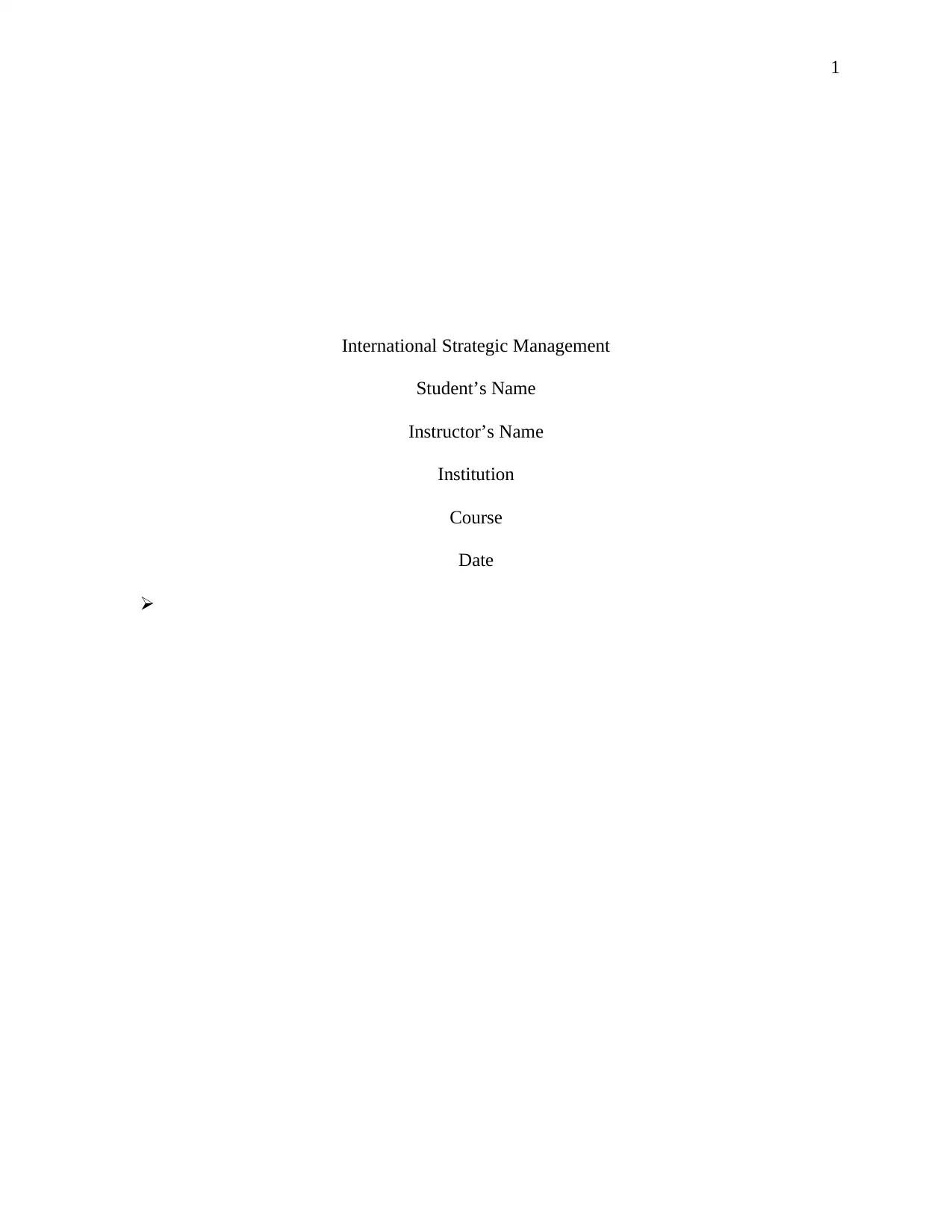
1
International Strategic Management
Student’s Name
Instructor’s Name
Institution
Course
Date
International Strategic Management
Student’s Name
Instructor’s Name
Institution
Course
Date
Secure Best Marks with AI Grader
Need help grading? Try our AI Grader for instant feedback on your assignments.
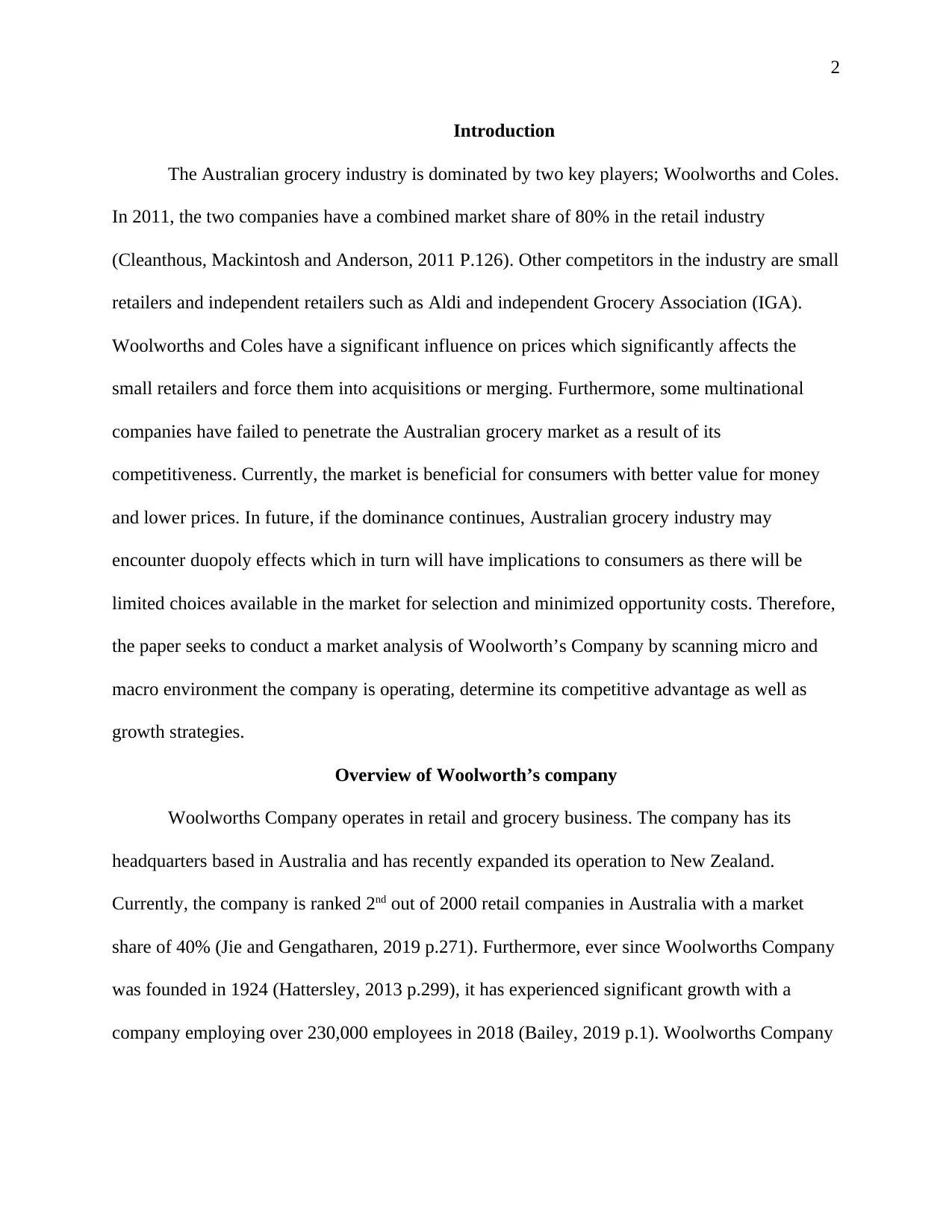
2
Introduction
The Australian grocery industry is dominated by two key players; Woolworths and Coles.
In 2011, the two companies have a combined market share of 80% in the retail industry
(Cleanthous, Mackintosh and Anderson, 2011 P.126). Other competitors in the industry are small
retailers and independent retailers such as Aldi and independent Grocery Association (IGA).
Woolworths and Coles have a significant influence on prices which significantly affects the
small retailers and force them into acquisitions or merging. Furthermore, some multinational
companies have failed to penetrate the Australian grocery market as a result of its
competitiveness. Currently, the market is beneficial for consumers with better value for money
and lower prices. In future, if the dominance continues, Australian grocery industry may
encounter duopoly effects which in turn will have implications to consumers as there will be
limited choices available in the market for selection and minimized opportunity costs. Therefore,
the paper seeks to conduct a market analysis of Woolworth’s Company by scanning micro and
macro environment the company is operating, determine its competitive advantage as well as
growth strategies.
Overview of Woolworth’s company
Woolworths Company operates in retail and grocery business. The company has its
headquarters based in Australia and has recently expanded its operation to New Zealand.
Currently, the company is ranked 2nd out of 2000 retail companies in Australia with a market
share of 40% (Jie and Gengatharen, 2019 p.271). Furthermore, ever since Woolworths Company
was founded in 1924 (Hattersley, 2013 p.299), it has experienced significant growth with a
company employing over 230,000 employees in 2018 (Bailey, 2019 p.1). Woolworths Company
Introduction
The Australian grocery industry is dominated by two key players; Woolworths and Coles.
In 2011, the two companies have a combined market share of 80% in the retail industry
(Cleanthous, Mackintosh and Anderson, 2011 P.126). Other competitors in the industry are small
retailers and independent retailers such as Aldi and independent Grocery Association (IGA).
Woolworths and Coles have a significant influence on prices which significantly affects the
small retailers and force them into acquisitions or merging. Furthermore, some multinational
companies have failed to penetrate the Australian grocery market as a result of its
competitiveness. Currently, the market is beneficial for consumers with better value for money
and lower prices. In future, if the dominance continues, Australian grocery industry may
encounter duopoly effects which in turn will have implications to consumers as there will be
limited choices available in the market for selection and minimized opportunity costs. Therefore,
the paper seeks to conduct a market analysis of Woolworth’s Company by scanning micro and
macro environment the company is operating, determine its competitive advantage as well as
growth strategies.
Overview of Woolworth’s company
Woolworths Company operates in retail and grocery business. The company has its
headquarters based in Australia and has recently expanded its operation to New Zealand.
Currently, the company is ranked 2nd out of 2000 retail companies in Australia with a market
share of 40% (Jie and Gengatharen, 2019 p.271). Furthermore, ever since Woolworths Company
was founded in 1924 (Hattersley, 2013 p.299), it has experienced significant growth with a
company employing over 230,000 employees in 2018 (Bailey, 2019 p.1). Woolworths Company
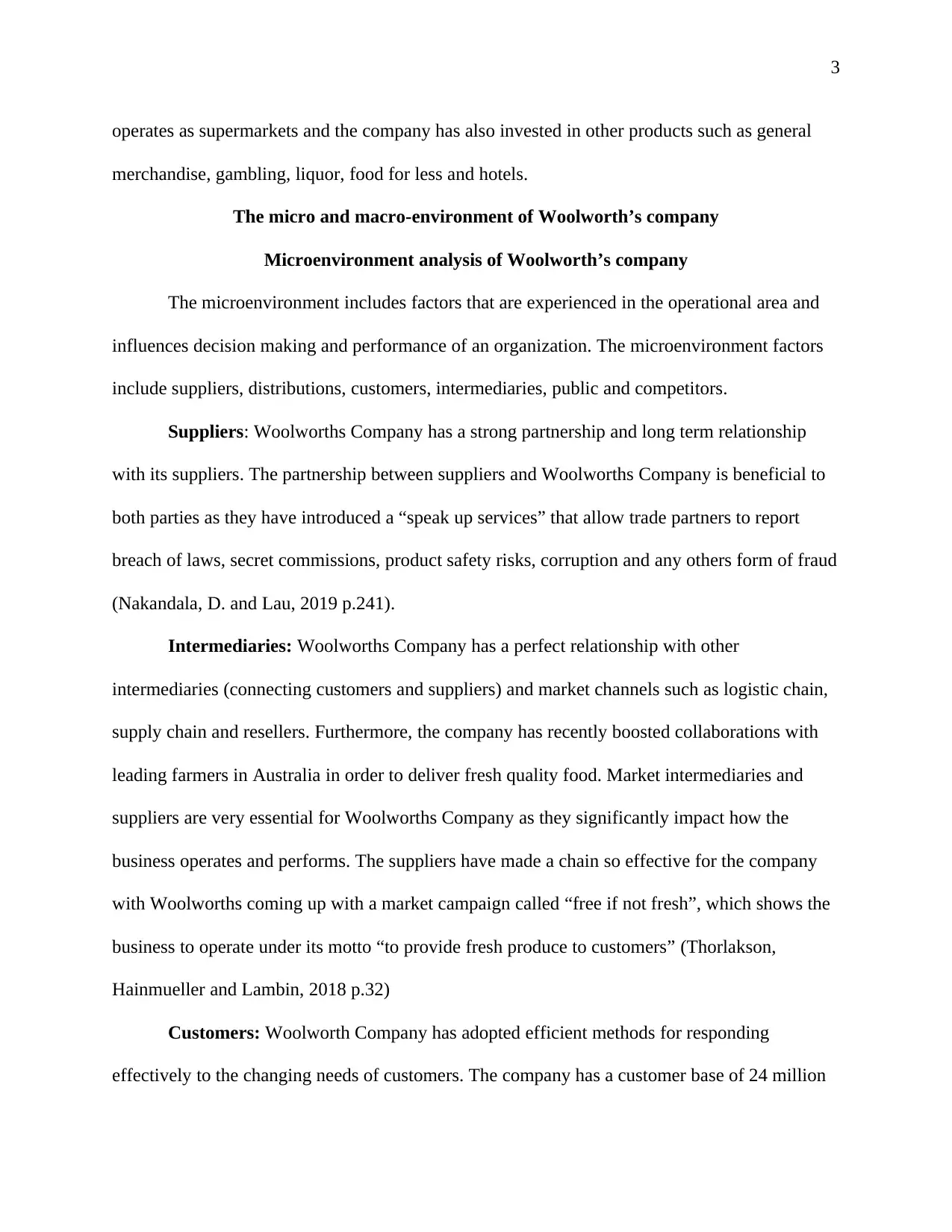
3
operates as supermarkets and the company has also invested in other products such as general
merchandise, gambling, liquor, food for less and hotels.
The micro and macro-environment of Woolworth’s company
Microenvironment analysis of Woolworth’s company
The microenvironment includes factors that are experienced in the operational area and
influences decision making and performance of an organization. The microenvironment factors
include suppliers, distributions, customers, intermediaries, public and competitors.
Suppliers: Woolworths Company has a strong partnership and long term relationship
with its suppliers. The partnership between suppliers and Woolworths Company is beneficial to
both parties as they have introduced a “speak up services” that allow trade partners to report
breach of laws, secret commissions, product safety risks, corruption and any others form of fraud
(Nakandala, D. and Lau, 2019 p.241).
Intermediaries: Woolworths Company has a perfect relationship with other
intermediaries (connecting customers and suppliers) and market channels such as logistic chain,
supply chain and resellers. Furthermore, the company has recently boosted collaborations with
leading farmers in Australia in order to deliver fresh quality food. Market intermediaries and
suppliers are very essential for Woolworths Company as they significantly impact how the
business operates and performs. The suppliers have made a chain so effective for the company
with Woolworths coming up with a market campaign called “free if not fresh”, which shows the
business to operate under its motto “to provide fresh produce to customers” (Thorlakson,
Hainmueller and Lambin, 2018 p.32)
Customers: Woolworth Company has adopted efficient methods for responding
effectively to the changing needs of customers. The company has a customer base of 24 million
operates as supermarkets and the company has also invested in other products such as general
merchandise, gambling, liquor, food for less and hotels.
The micro and macro-environment of Woolworth’s company
Microenvironment analysis of Woolworth’s company
The microenvironment includes factors that are experienced in the operational area and
influences decision making and performance of an organization. The microenvironment factors
include suppliers, distributions, customers, intermediaries, public and competitors.
Suppliers: Woolworths Company has a strong partnership and long term relationship
with its suppliers. The partnership between suppliers and Woolworths Company is beneficial to
both parties as they have introduced a “speak up services” that allow trade partners to report
breach of laws, secret commissions, product safety risks, corruption and any others form of fraud
(Nakandala, D. and Lau, 2019 p.241).
Intermediaries: Woolworths Company has a perfect relationship with other
intermediaries (connecting customers and suppliers) and market channels such as logistic chain,
supply chain and resellers. Furthermore, the company has recently boosted collaborations with
leading farmers in Australia in order to deliver fresh quality food. Market intermediaries and
suppliers are very essential for Woolworths Company as they significantly impact how the
business operates and performs. The suppliers have made a chain so effective for the company
with Woolworths coming up with a market campaign called “free if not fresh”, which shows the
business to operate under its motto “to provide fresh produce to customers” (Thorlakson,
Hainmueller and Lambin, 2018 p.32)
Customers: Woolworth Company has adopted efficient methods for responding
effectively to the changing needs of customers. The company has a customer base of 24 million
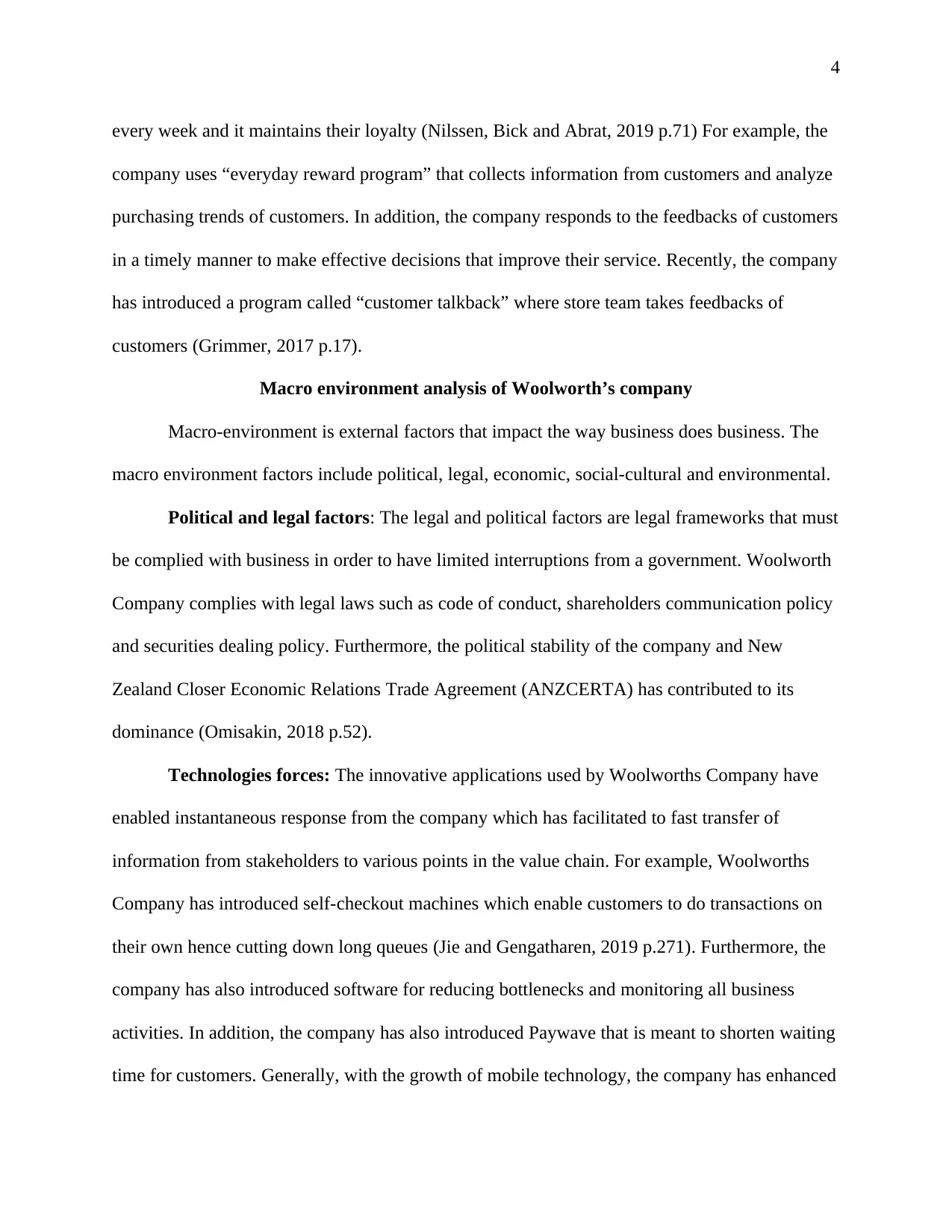
4
every week and it maintains their loyalty (Nilssen, Bick and Abrat, 2019 p.71) For example, the
company uses “everyday reward program” that collects information from customers and analyze
purchasing trends of customers. In addition, the company responds to the feedbacks of customers
in a timely manner to make effective decisions that improve their service. Recently, the company
has introduced a program called “customer talkback” where store team takes feedbacks of
customers (Grimmer, 2017 p.17).
Macro environment analysis of Woolworth’s company
Macro-environment is external factors that impact the way business does business. The
macro environment factors include political, legal, economic, social-cultural and environmental.
Political and legal factors: The legal and political factors are legal frameworks that must
be complied with business in order to have limited interruptions from a government. Woolworth
Company complies with legal laws such as code of conduct, shareholders communication policy
and securities dealing policy. Furthermore, the political stability of the company and New
Zealand Closer Economic Relations Trade Agreement (ANZCERTA) has contributed to its
dominance (Omisakin, 2018 p.52).
Technologies forces: The innovative applications used by Woolworths Company have
enabled instantaneous response from the company which has facilitated to fast transfer of
information from stakeholders to various points in the value chain. For example, Woolworths
Company has introduced self-checkout machines which enable customers to do transactions on
their own hence cutting down long queues (Jie and Gengatharen, 2019 p.271). Furthermore, the
company has also introduced software for reducing bottlenecks and monitoring all business
activities. In addition, the company has also introduced Paywave that is meant to shorten waiting
time for customers. Generally, with the growth of mobile technology, the company has enhanced
every week and it maintains their loyalty (Nilssen, Bick and Abrat, 2019 p.71) For example, the
company uses “everyday reward program” that collects information from customers and analyze
purchasing trends of customers. In addition, the company responds to the feedbacks of customers
in a timely manner to make effective decisions that improve their service. Recently, the company
has introduced a program called “customer talkback” where store team takes feedbacks of
customers (Grimmer, 2017 p.17).
Macro environment analysis of Woolworth’s company
Macro-environment is external factors that impact the way business does business. The
macro environment factors include political, legal, economic, social-cultural and environmental.
Political and legal factors: The legal and political factors are legal frameworks that must
be complied with business in order to have limited interruptions from a government. Woolworth
Company complies with legal laws such as code of conduct, shareholders communication policy
and securities dealing policy. Furthermore, the political stability of the company and New
Zealand Closer Economic Relations Trade Agreement (ANZCERTA) has contributed to its
dominance (Omisakin, 2018 p.52).
Technologies forces: The innovative applications used by Woolworths Company have
enabled instantaneous response from the company which has facilitated to fast transfer of
information from stakeholders to various points in the value chain. For example, Woolworths
Company has introduced self-checkout machines which enable customers to do transactions on
their own hence cutting down long queues (Jie and Gengatharen, 2019 p.271). Furthermore, the
company has also introduced software for reducing bottlenecks and monitoring all business
activities. In addition, the company has also introduced Paywave that is meant to shorten waiting
time for customers. Generally, with the growth of mobile technology, the company has enhanced
Secure Best Marks with AI Grader
Need help grading? Try our AI Grader for instant feedback on your assignments.
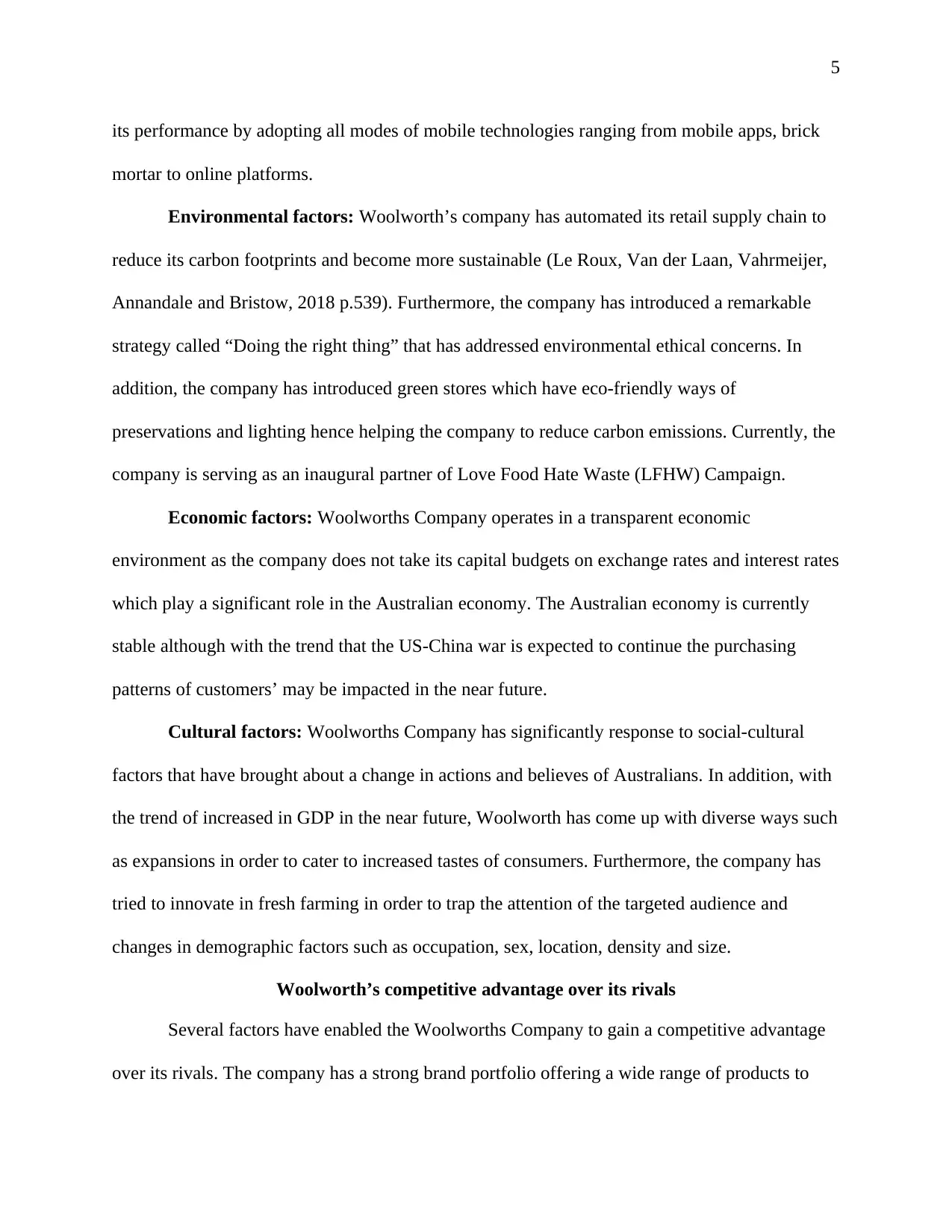
5
its performance by adopting all modes of mobile technologies ranging from mobile apps, brick
mortar to online platforms.
Environmental factors: Woolworth’s company has automated its retail supply chain to
reduce its carbon footprints and become more sustainable (Le Roux, Van der Laan, Vahrmeijer,
Annandale and Bristow, 2018 p.539). Furthermore, the company has introduced a remarkable
strategy called “Doing the right thing” that has addressed environmental ethical concerns. In
addition, the company has introduced green stores which have eco-friendly ways of
preservations and lighting hence helping the company to reduce carbon emissions. Currently, the
company is serving as an inaugural partner of Love Food Hate Waste (LFHW) Campaign.
Economic factors: Woolworths Company operates in a transparent economic
environment as the company does not take its capital budgets on exchange rates and interest rates
which play a significant role in the Australian economy. The Australian economy is currently
stable although with the trend that the US-China war is expected to continue the purchasing
patterns of customers’ may be impacted in the near future.
Cultural factors: Woolworths Company has significantly response to social-cultural
factors that have brought about a change in actions and believes of Australians. In addition, with
the trend of increased in GDP in the near future, Woolworth has come up with diverse ways such
as expansions in order to cater to increased tastes of consumers. Furthermore, the company has
tried to innovate in fresh farming in order to trap the attention of the targeted audience and
changes in demographic factors such as occupation, sex, location, density and size.
Woolworth’s competitive advantage over its rivals
Several factors have enabled the Woolworths Company to gain a competitive advantage
over its rivals. The company has a strong brand portfolio offering a wide range of products to
its performance by adopting all modes of mobile technologies ranging from mobile apps, brick
mortar to online platforms.
Environmental factors: Woolworth’s company has automated its retail supply chain to
reduce its carbon footprints and become more sustainable (Le Roux, Van der Laan, Vahrmeijer,
Annandale and Bristow, 2018 p.539). Furthermore, the company has introduced a remarkable
strategy called “Doing the right thing” that has addressed environmental ethical concerns. In
addition, the company has introduced green stores which have eco-friendly ways of
preservations and lighting hence helping the company to reduce carbon emissions. Currently, the
company is serving as an inaugural partner of Love Food Hate Waste (LFHW) Campaign.
Economic factors: Woolworths Company operates in a transparent economic
environment as the company does not take its capital budgets on exchange rates and interest rates
which play a significant role in the Australian economy. The Australian economy is currently
stable although with the trend that the US-China war is expected to continue the purchasing
patterns of customers’ may be impacted in the near future.
Cultural factors: Woolworths Company has significantly response to social-cultural
factors that have brought about a change in actions and believes of Australians. In addition, with
the trend of increased in GDP in the near future, Woolworth has come up with diverse ways such
as expansions in order to cater to increased tastes of consumers. Furthermore, the company has
tried to innovate in fresh farming in order to trap the attention of the targeted audience and
changes in demographic factors such as occupation, sex, location, density and size.
Woolworth’s competitive advantage over its rivals
Several factors have enabled the Woolworths Company to gain a competitive advantage
over its rivals. The company has a strong brand portfolio offering a wide range of products to
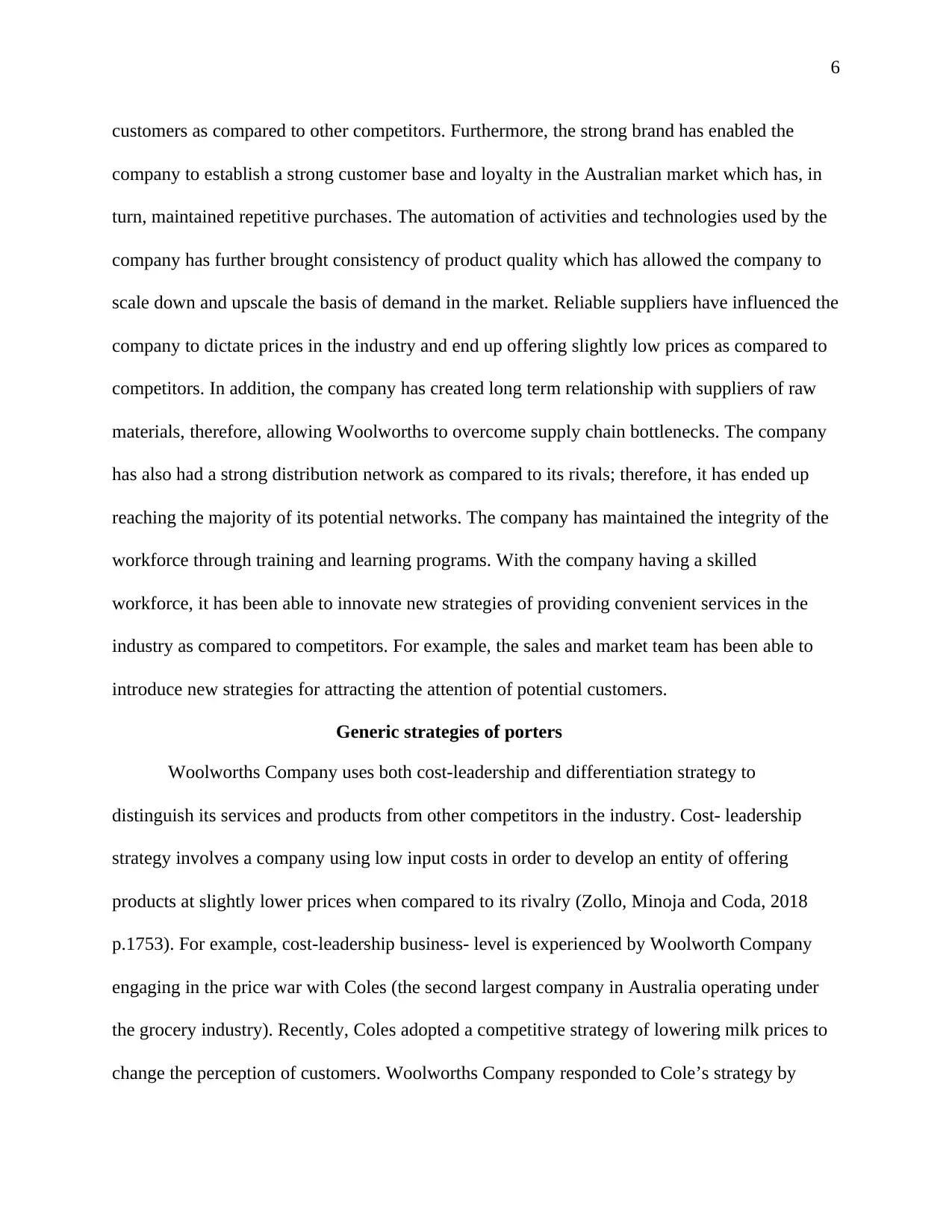
6
customers as compared to other competitors. Furthermore, the strong brand has enabled the
company to establish a strong customer base and loyalty in the Australian market which has, in
turn, maintained repetitive purchases. The automation of activities and technologies used by the
company has further brought consistency of product quality which has allowed the company to
scale down and upscale the basis of demand in the market. Reliable suppliers have influenced the
company to dictate prices in the industry and end up offering slightly low prices as compared to
competitors. In addition, the company has created long term relationship with suppliers of raw
materials, therefore, allowing Woolworths to overcome supply chain bottlenecks. The company
has also had a strong distribution network as compared to its rivals; therefore, it has ended up
reaching the majority of its potential networks. The company has maintained the integrity of the
workforce through training and learning programs. With the company having a skilled
workforce, it has been able to innovate new strategies of providing convenient services in the
industry as compared to competitors. For example, the sales and market team has been able to
introduce new strategies for attracting the attention of potential customers.
Generic strategies of porters
Woolworths Company uses both cost-leadership and differentiation strategy to
distinguish its services and products from other competitors in the industry. Cost- leadership
strategy involves a company using low input costs in order to develop an entity of offering
products at slightly lower prices when compared to its rivalry (Zollo, Minoja and Coda, 2018
p.1753). For example, cost-leadership business- level is experienced by Woolworth Company
engaging in the price war with Coles (the second largest company in Australia operating under
the grocery industry). Recently, Coles adopted a competitive strategy of lowering milk prices to
change the perception of customers. Woolworths Company responded to Cole’s strategy by
customers as compared to other competitors. Furthermore, the strong brand has enabled the
company to establish a strong customer base and loyalty in the Australian market which has, in
turn, maintained repetitive purchases. The automation of activities and technologies used by the
company has further brought consistency of product quality which has allowed the company to
scale down and upscale the basis of demand in the market. Reliable suppliers have influenced the
company to dictate prices in the industry and end up offering slightly low prices as compared to
competitors. In addition, the company has created long term relationship with suppliers of raw
materials, therefore, allowing Woolworths to overcome supply chain bottlenecks. The company
has also had a strong distribution network as compared to its rivals; therefore, it has ended up
reaching the majority of its potential networks. The company has maintained the integrity of the
workforce through training and learning programs. With the company having a skilled
workforce, it has been able to innovate new strategies of providing convenient services in the
industry as compared to competitors. For example, the sales and market team has been able to
introduce new strategies for attracting the attention of potential customers.
Generic strategies of porters
Woolworths Company uses both cost-leadership and differentiation strategy to
distinguish its services and products from other competitors in the industry. Cost- leadership
strategy involves a company using low input costs in order to develop an entity of offering
products at slightly lower prices when compared to its rivalry (Zollo, Minoja and Coda, 2018
p.1753). For example, cost-leadership business- level is experienced by Woolworth Company
engaging in the price war with Coles (the second largest company in Australia operating under
the grocery industry). Recently, Coles adopted a competitive strategy of lowering milk prices to
change the perception of customers. Woolworths Company responded to Cole’s strategy by

7
lowering its milk to similar levels. Woolworth also adopts the cost-leadership strategy by
controlling a large chain of supermarkets which has recently increased purchasing power and
forced the suppliers to low their prices. Recently, Woolworths appears to have adopted a focus
strategy in some business functions unit. For example, in 2012, the company engaged in
activities such as integration of sushi bar, bag and bake, beef and lamb and MSA Beef which
significantly shows the company targeted specific customers (Vangchhia, Blyton, Collignon,
Kennedy and Gordon, 2018 p.1350). On the other hand, differentiation strategy is the way a
company comes up with a unique value to the customers by providing customers with services
and products with special features that distinguish it from it rivalries The companies use
initiatives such provision of the environment-friendly approach of conducting its business to
differentiate itself.
Woolworth’s growth strategies
Woolworth’s adopts Ansoff matrix in order to grow in the market. Ansoff matrix
adopted by Woolworth Company involves four strategies of market penetration, product
development, market development and diversification. In market penetration phase, Woolworths
Company focuses on increasing sales of existing products in the existing market. For example,
Woolworths Company lowers its prices at the local market where it has strong customer loyalty
and base to facilitate more sales. Furthermore, the company has also increased promotional
activities and distribution networks regionally to increase its market share. In the product
development phase, Woolworths focuses on introducing a new product to an existing market. For
example, Woolworths has started offering differentiated products such as beef into its stores after
a strong understanding of the current customer needs in the market. Furthermore, the company
has been able to invest in Research and Development (R&D) to come up with innovative
lowering its milk to similar levels. Woolworth also adopts the cost-leadership strategy by
controlling a large chain of supermarkets which has recently increased purchasing power and
forced the suppliers to low their prices. Recently, Woolworths appears to have adopted a focus
strategy in some business functions unit. For example, in 2012, the company engaged in
activities such as integration of sushi bar, bag and bake, beef and lamb and MSA Beef which
significantly shows the company targeted specific customers (Vangchhia, Blyton, Collignon,
Kennedy and Gordon, 2018 p.1350). On the other hand, differentiation strategy is the way a
company comes up with a unique value to the customers by providing customers with services
and products with special features that distinguish it from it rivalries The companies use
initiatives such provision of the environment-friendly approach of conducting its business to
differentiate itself.
Woolworth’s growth strategies
Woolworth’s adopts Ansoff matrix in order to grow in the market. Ansoff matrix
adopted by Woolworth Company involves four strategies of market penetration, product
development, market development and diversification. In market penetration phase, Woolworths
Company focuses on increasing sales of existing products in the existing market. For example,
Woolworths Company lowers its prices at the local market where it has strong customer loyalty
and base to facilitate more sales. Furthermore, the company has also increased promotional
activities and distribution networks regionally to increase its market share. In the product
development phase, Woolworths focuses on introducing a new product to an existing market. For
example, Woolworths has started offering differentiated products such as beef into its stores after
a strong understanding of the current customer needs in the market. Furthermore, the company
has been able to invest in Research and Development (R&D) to come up with innovative
Paraphrase This Document
Need a fresh take? Get an instant paraphrase of this document with our AI Paraphraser
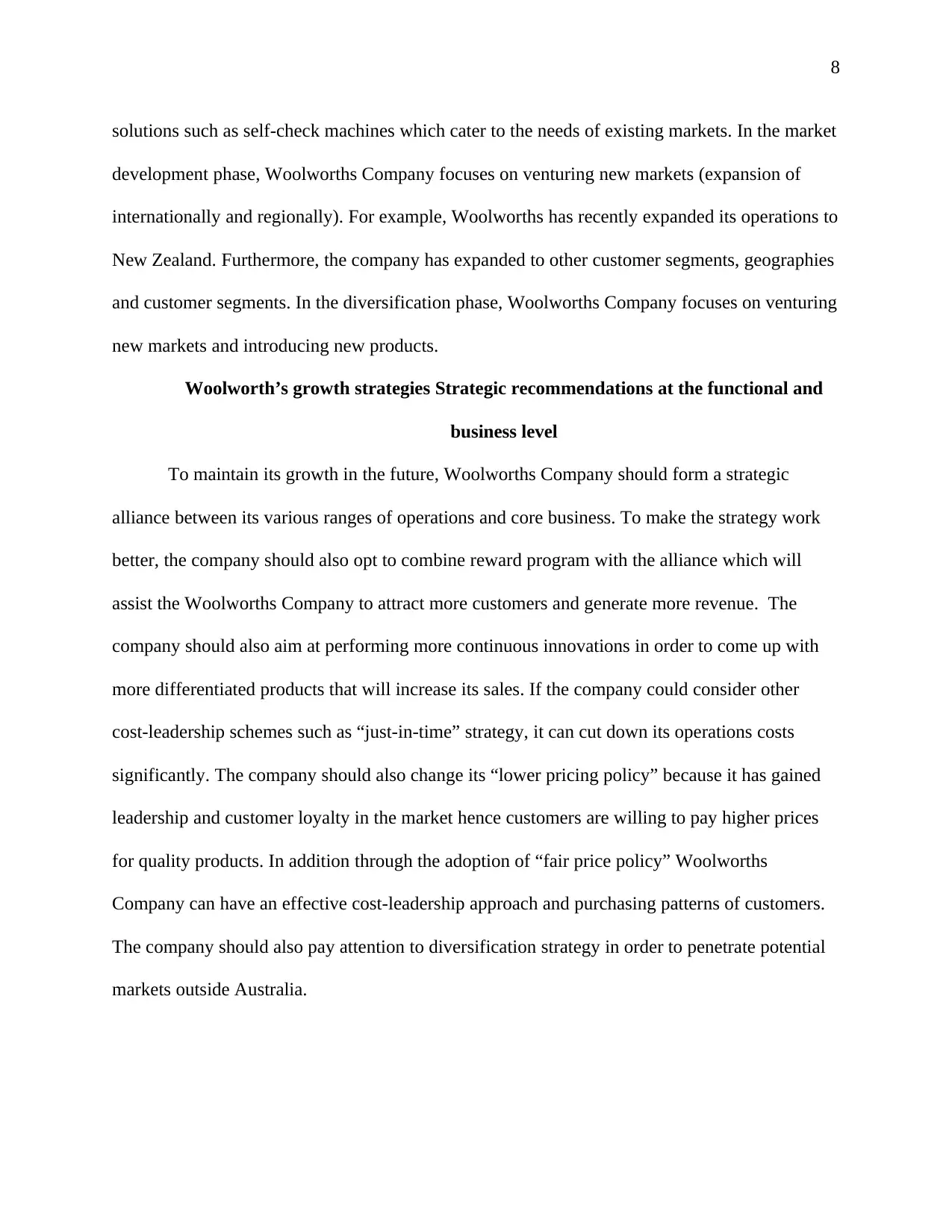
8
solutions such as self-check machines which cater to the needs of existing markets. In the market
development phase, Woolworths Company focuses on venturing new markets (expansion of
internationally and regionally). For example, Woolworths has recently expanded its operations to
New Zealand. Furthermore, the company has expanded to other customer segments, geographies
and customer segments. In the diversification phase, Woolworths Company focuses on venturing
new markets and introducing new products.
Woolworth’s growth strategies Strategic recommendations at the functional and
business level
To maintain its growth in the future, Woolworths Company should form a strategic
alliance between its various ranges of operations and core business. To make the strategy work
better, the company should also opt to combine reward program with the alliance which will
assist the Woolworths Company to attract more customers and generate more revenue. The
company should also aim at performing more continuous innovations in order to come up with
more differentiated products that will increase its sales. If the company could consider other
cost-leadership schemes such as “just-in-time” strategy, it can cut down its operations costs
significantly. The company should also change its “lower pricing policy” because it has gained
leadership and customer loyalty in the market hence customers are willing to pay higher prices
for quality products. In addition through the adoption of “fair price policy” Woolworths
Company can have an effective cost-leadership approach and purchasing patterns of customers.
The company should also pay attention to diversification strategy in order to penetrate potential
markets outside Australia.
solutions such as self-check machines which cater to the needs of existing markets. In the market
development phase, Woolworths Company focuses on venturing new markets (expansion of
internationally and regionally). For example, Woolworths has recently expanded its operations to
New Zealand. Furthermore, the company has expanded to other customer segments, geographies
and customer segments. In the diversification phase, Woolworths Company focuses on venturing
new markets and introducing new products.
Woolworth’s growth strategies Strategic recommendations at the functional and
business level
To maintain its growth in the future, Woolworths Company should form a strategic
alliance between its various ranges of operations and core business. To make the strategy work
better, the company should also opt to combine reward program with the alliance which will
assist the Woolworths Company to attract more customers and generate more revenue. The
company should also aim at performing more continuous innovations in order to come up with
more differentiated products that will increase its sales. If the company could consider other
cost-leadership schemes such as “just-in-time” strategy, it can cut down its operations costs
significantly. The company should also change its “lower pricing policy” because it has gained
leadership and customer loyalty in the market hence customers are willing to pay higher prices
for quality products. In addition through the adoption of “fair price policy” Woolworths
Company can have an effective cost-leadership approach and purchasing patterns of customers.
The company should also pay attention to diversification strategy in order to penetrate potential
markets outside Australia.
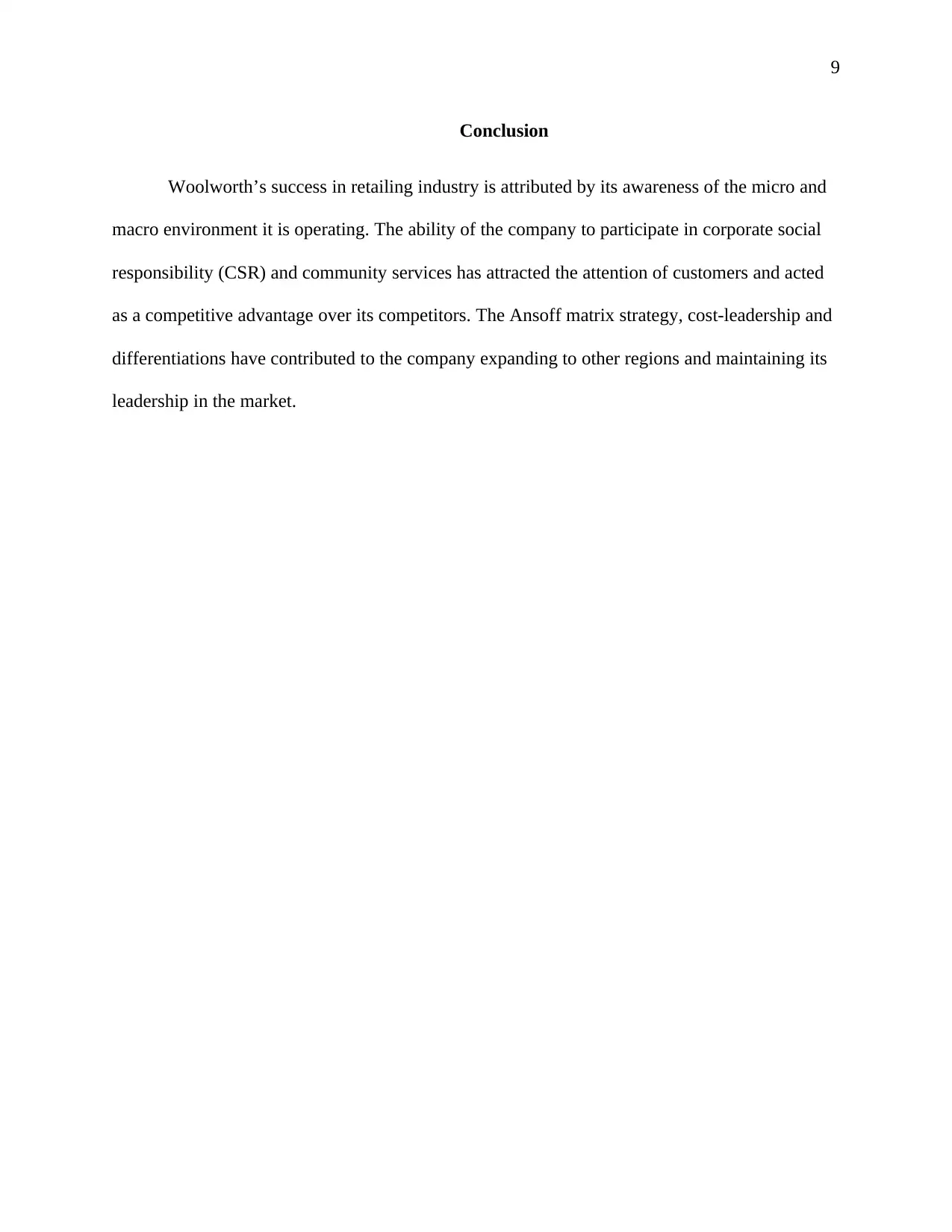
9
Conclusion
Woolworth’s success in retailing industry is attributed by its awareness of the micro and
macro environment it is operating. The ability of the company to participate in corporate social
responsibility (CSR) and community services has attracted the attention of customers and acted
as a competitive advantage over its competitors. The Ansoff matrix strategy, cost-leadership and
differentiations have contributed to the company expanding to other regions and maintaining its
leadership in the market.
Conclusion
Woolworth’s success in retailing industry is attributed by its awareness of the micro and
macro environment it is operating. The ability of the company to participate in corporate social
responsibility (CSR) and community services has attracted the attention of customers and acted
as a competitive advantage over its competitors. The Ansoff matrix strategy, cost-leadership and
differentiations have contributed to the company expanding to other regions and maintaining its
leadership in the market.
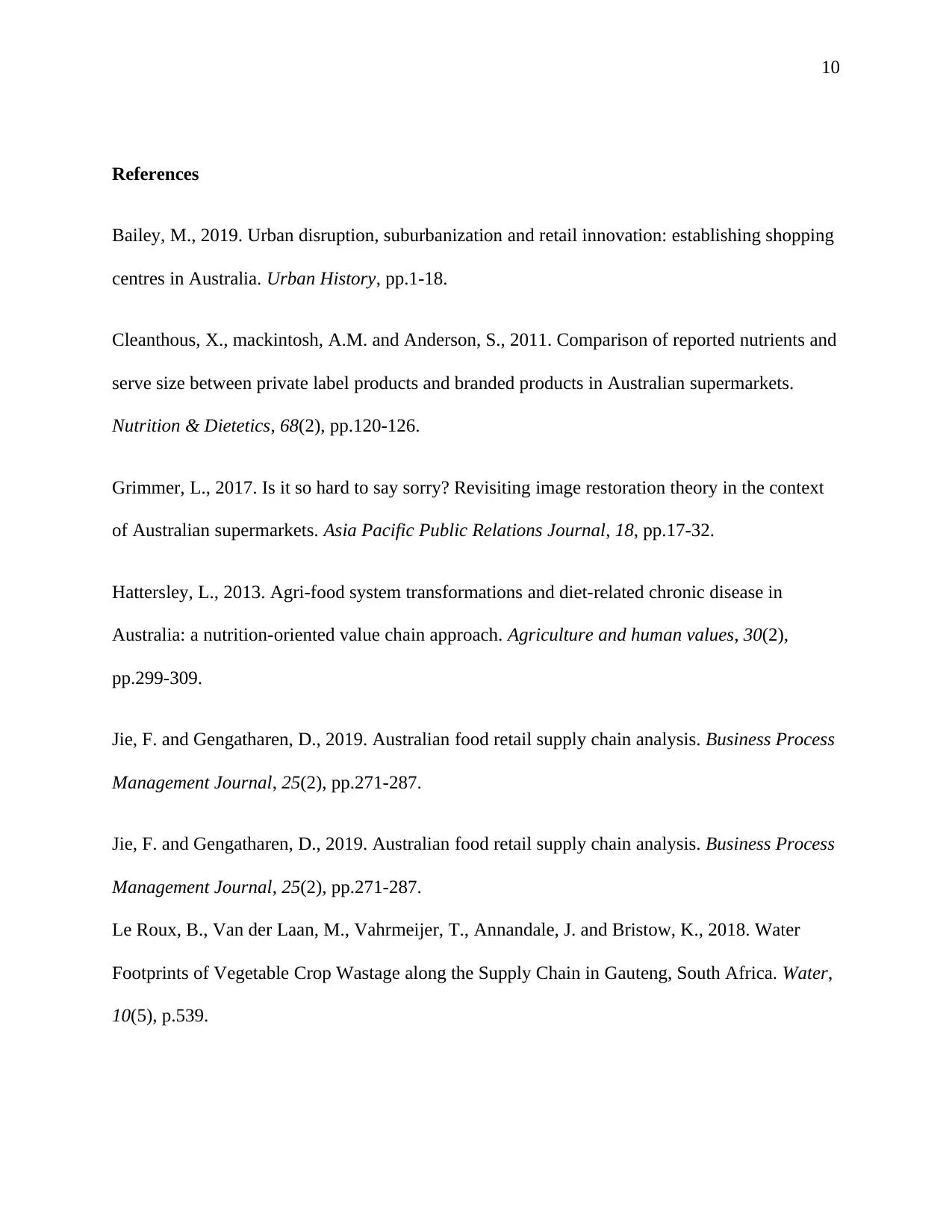
10
References
Bailey, M., 2019. Urban disruption, suburbanization and retail innovation: establishing shopping
centres in Australia. Urban History, pp.1-18.
Cleanthous, X., mackintosh, A.M. and Anderson, S., 2011. Comparison of reported nutrients and
serve size between private label products and branded products in Australian supermarkets.
Nutrition & Dietetics, 68(2), pp.120-126.
Grimmer, L., 2017. Is it so hard to say sorry? Revisiting image restoration theory in the context
of Australian supermarkets. Asia Pacific Public Relations Journal, 18, pp.17-32.
Hattersley, L., 2013. Agri-food system transformations and diet-related chronic disease in
Australia: a nutrition-oriented value chain approach. Agriculture and human values, 30(2),
pp.299-309.
Jie, F. and Gengatharen, D., 2019. Australian food retail supply chain analysis. Business Process
Management Journal, 25(2), pp.271-287.
Jie, F. and Gengatharen, D., 2019. Australian food retail supply chain analysis. Business Process
Management Journal, 25(2), pp.271-287.
Le Roux, B., Van der Laan, M., Vahrmeijer, T., Annandale, J. and Bristow, K., 2018. Water
Footprints of Vegetable Crop Wastage along the Supply Chain in Gauteng, South Africa. Water,
10(5), p.539.
References
Bailey, M., 2019. Urban disruption, suburbanization and retail innovation: establishing shopping
centres in Australia. Urban History, pp.1-18.
Cleanthous, X., mackintosh, A.M. and Anderson, S., 2011. Comparison of reported nutrients and
serve size between private label products and branded products in Australian supermarkets.
Nutrition & Dietetics, 68(2), pp.120-126.
Grimmer, L., 2017. Is it so hard to say sorry? Revisiting image restoration theory in the context
of Australian supermarkets. Asia Pacific Public Relations Journal, 18, pp.17-32.
Hattersley, L., 2013. Agri-food system transformations and diet-related chronic disease in
Australia: a nutrition-oriented value chain approach. Agriculture and human values, 30(2),
pp.299-309.
Jie, F. and Gengatharen, D., 2019. Australian food retail supply chain analysis. Business Process
Management Journal, 25(2), pp.271-287.
Jie, F. and Gengatharen, D., 2019. Australian food retail supply chain analysis. Business Process
Management Journal, 25(2), pp.271-287.
Le Roux, B., Van der Laan, M., Vahrmeijer, T., Annandale, J. and Bristow, K., 2018. Water
Footprints of Vegetable Crop Wastage along the Supply Chain in Gauteng, South Africa. Water,
10(5), p.539.
Secure Best Marks with AI Grader
Need help grading? Try our AI Grader for instant feedback on your assignments.

11
Nakandala, D. and Lau, H.C., 2019. Innovative adoption of hybrid supply chain strategies in
urban local fresh food supply chain. Supply Chain Management: An International Journal,
24(2), pp.241-255.
Nilssen, R., Bick, G. and Abratt, R., 2019. Comparing the relative importance of sustainability as
a consumer purchase criterion of food and clothing in the retail sector. Journal of Brand
Management, 26(1), pp.71-83.
Omisakin, O.M., 2018. New Zealand Trade Agreements and Their Economic and Societal
Impacts: A Review. International Business and Management, 16(2), pp.52-62.
Thorlakson, T., Hainmueller, J. and Lambin, E.F., 2018. Improving environmental practices in
agricultural supply chains: The role of company-led standards. Global environmental change, 48,
pp.32-42.
Vangchhia, B., Blyton, M.D., Collignon, P., Kennedy, K. and Gordon, D.M., 2018. Factors
affecting the presence, genetic diversity and antimicrobial sensitivity of Escherichia coli in
poultry meat samples collected from Canberra, Australia. Environmental microbiology, 20(4),
pp.1350-1361.
Zollo, M., Minoja, M. and Coda, V., 2018. Toward an integrated theory of strategy. Strategic
Management Journal, 39(6), pp.1753-1778.
Nakandala, D. and Lau, H.C., 2019. Innovative adoption of hybrid supply chain strategies in
urban local fresh food supply chain. Supply Chain Management: An International Journal,
24(2), pp.241-255.
Nilssen, R., Bick, G. and Abratt, R., 2019. Comparing the relative importance of sustainability as
a consumer purchase criterion of food and clothing in the retail sector. Journal of Brand
Management, 26(1), pp.71-83.
Omisakin, O.M., 2018. New Zealand Trade Agreements and Their Economic and Societal
Impacts: A Review. International Business and Management, 16(2), pp.52-62.
Thorlakson, T., Hainmueller, J. and Lambin, E.F., 2018. Improving environmental practices in
agricultural supply chains: The role of company-led standards. Global environmental change, 48,
pp.32-42.
Vangchhia, B., Blyton, M.D., Collignon, P., Kennedy, K. and Gordon, D.M., 2018. Factors
affecting the presence, genetic diversity and antimicrobial sensitivity of Escherichia coli in
poultry meat samples collected from Canberra, Australia. Environmental microbiology, 20(4),
pp.1350-1361.
Zollo, M., Minoja, M. and Coda, V., 2018. Toward an integrated theory of strategy. Strategic
Management Journal, 39(6), pp.1753-1778.
1 out of 11
Related Documents
Your All-in-One AI-Powered Toolkit for Academic Success.
+13062052269
info@desklib.com
Available 24*7 on WhatsApp / Email
![[object Object]](/_next/static/media/star-bottom.7253800d.svg)
Unlock your academic potential
© 2024 | Zucol Services PVT LTD | All rights reserved.





